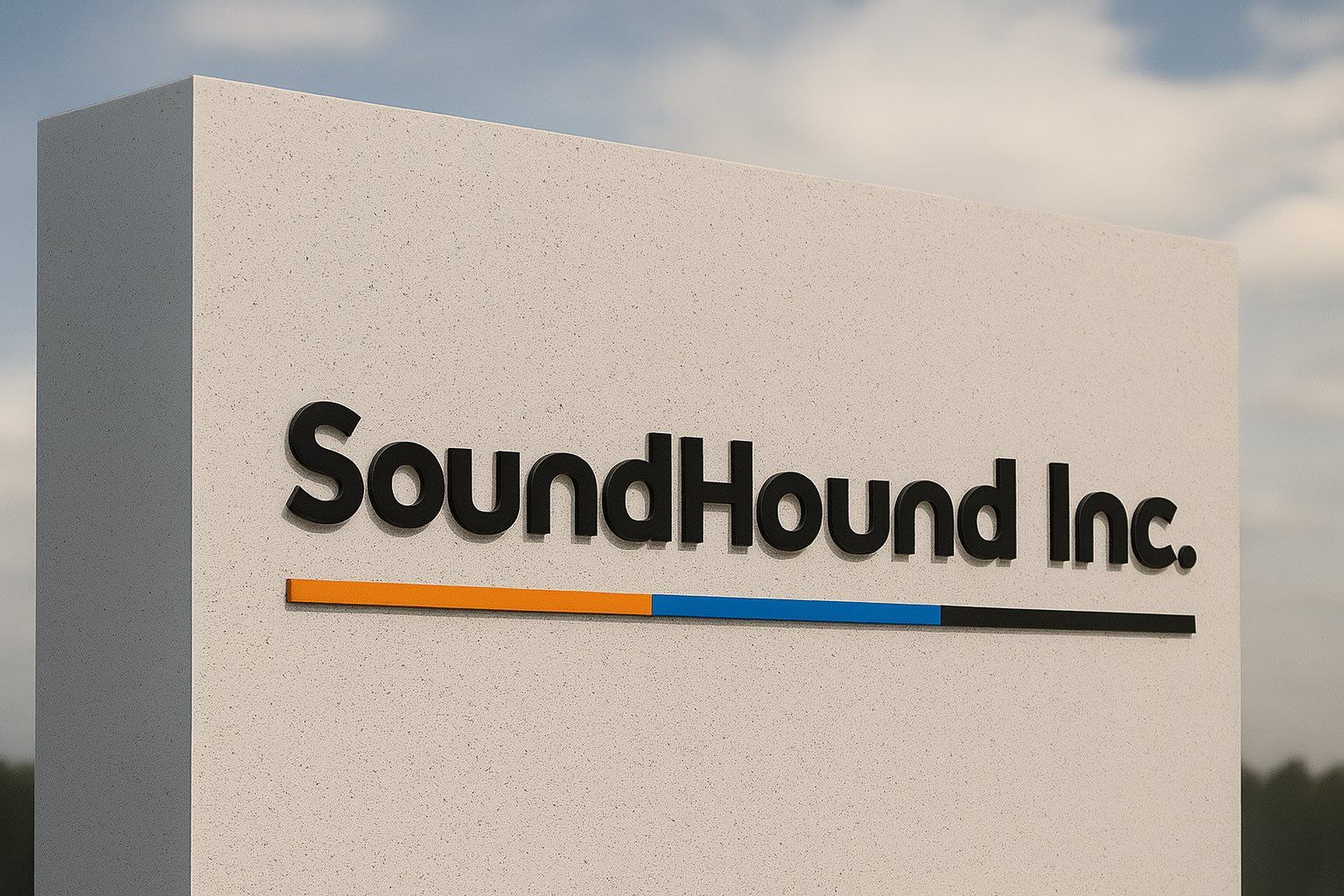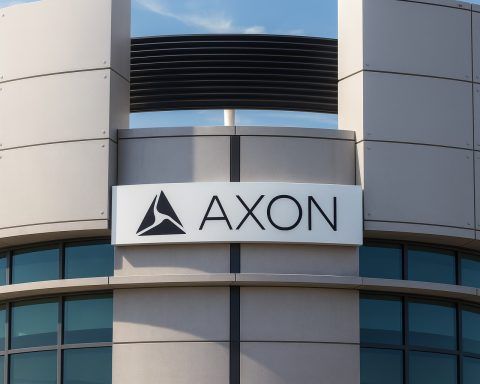Key Facts (Nov 4, 2025):
- Stock Price: ~$15.24 per share (NASDAQ: SOUN) [1] (down ~11% in today’s trading).
- 1-Month Performance: approximately -5% [2] (amid high volatility); YTD:-24% [3].
- Market Capitalization: around $7.0 billion [4].
- Sector/Industry: Information Technology – Software (Voice & Conversational AI) [5].
- Latest Earnings: Q2 2025 revenue $42.7 M (up +217% YoY – a record) [6]; adjusted net loss -$0.03 per share (narrowed from -$0.04) [7], beating analyst expectations. Full-year 2025 revenue guidance was raised to $160–178 M [8] (above consensus).
Recent News: Pre-Earnings Jitters and Price Swings
SoundHound AI’s stock has seen sharp swings in early November 2025, reflecting investor jitters ahead of earnings. On November 4, shares fell ~7–10% intraday as traders took profits and grew cautious about high valuations and continued losses [9] [10]. The pullback came just days before SoundHound’s Q3 results (due Nov 6) and followed a significant rally in prior weeks. Market sentiment turned nervous with concerns that SoundHound’s AI optimism may be fully priced in and questions about when profitability will be achieved [11]. Broader market caution towards richly valued tech stocks compounded the volatility.
Despite the single-day drop, it’s important to note how far SoundHound’s stock has come in the past year. At ~$15, shares trade about 37% below their 52-week high near $24.98 (reached in late 2024) [12] [13]. Yet even after recent declines, the stock is up over 200% year-on-year [14], a testament to the intense AI-related enthusiasm that propelled SoundHound earlier in 2025. In fact, SoundHound’s last earnings report in August triggered a 54% weekly surge in the stock price [15]. Such dramatic moves underscore the extreme volatility at play – SoundHound has logged over 90 trading days of >5% swings in the past year [16]. For context, the shares even hit an all-time low under $1 during late 2022’s market trough [17], before riding the AI boom to multi-year highs. Investors should therefore be prepared for continued large price fluctuations around news events.
Explosive Growth vs. Ongoing Losses: Earnings in Focus
SoundHound’s financial story is a mix of rapid growth and persistent losses. The company’s Q2 2025 results were eye-catching – revenue reached $42.7 million (a +217% YoY jump) [18], marking an all-time high quarter as new AI products gained traction. This top-line result crushed Wall Street’s expectations (analysts had forecast ~$32–33 M) [19] [20], and the stock spiked over 50% on the news. SoundHound also showed improved efficiency: its adjusted net loss per share was -$0.03, a slight improvement from -$0.04 a year ago [21] and much better than the -$0.09 per share loss analysts had feared [22]. Management seized the moment to raise full-year revenue guidance to $160–178 M (from a prior ~$140–160 M range) [23], signaling confidence in sustained demand. Notably, at the midpoint of that outlook, SoundHound’s 2025 revenue would be ~160% higher than 2024 – staggering growth for a mid-cap software company.
However, profitability remains a distant goal. Even as adjusted losses narrowed, SoundHound’s GAAP net loss ballooned to -$74.7 M in Q2 [24] due to heavy costs (including stock-based expenses and acquisition-related accounting). Operating cash burn accelerated to about $24.7 M in Q2, worse than the ~$18.7 M burnt a year prior [25]. The company is sustaining operations by tapping capital markets – issuing new shares – which has diluted existing shareholders [26] [27]. In short, SoundHound is still firmly in “growth mode”: aggressively investing in R&D and sales to capture market share, while relying on its cash reserves ($230 M in cash as of mid-2025, with zero debt [28]) to fund losses. This trade-off was summed up by one analyst who noted that despite triple-digit revenue gains, SoundHound’s fundamentals (cash burn, margins, dilution) “still raise an eyebrow.” [29] [30] Investors will be watching the Q3 2025 earnings (to be reported Nov 6) for progress on these fronts – e.g. revenue growth near the ~$40 M mark (consensus ~+60% YoY) and any updates on the path toward breakeven [31] [32]. Market expectations have been running high, which is a double-edged sword: SoundHound’s last big quarter set a high bar, and any sign of growth slowdown or a larger-than-expected loss could spur another stock pullback. Indeed, the stock’s November dip suggests some traders braced for a wider Q3 loss than previously projected [33].
Analyst Views: Bullish Long-Term, Cautious Near-Term
Opinions on SoundHound AI’s stock vary widely, reflecting its potential – and its peril. Wall Street analysts, in aggregate, remain moderately bullish. According to TipRanks data, SoundHound has a “Moderate Buy” consensus with 5 Buy ratings and 2 Holds in recent months [34]. Price targets, however, are all over the map. The average target is around $16–17 (roughly where shares traded in early November) [35], indicating that many analysts think the stock’s hefty 2025 gains already price in much of the good news. In fact, some analysts have been caught off-guard by the rally – SoundHound’s stock surged ~90% in the past six months, far outpacing earlier target prices [36]. This has led a few to turn cautious: for example, Zacks highlighted that while SoundHound’s revenue “soaring” and AI expansion show promise, its mounting losses leave investors wary about whether to take profits ahead of earnings (hinting at a Hold stance). [37] Similarly, a recent Motley Fool commentary lauded SoundHound’s growth but ultimately rated it “more of a Hold than a strong buy” at current valuations [38].
On the bullish end of the spectrum, H.C. Wainwright sees major upside. Last month their analyst Scott Buck raised his price target to $26 (from $18) – the highest on the Street [39]. Buck argues that SoundHound could climb 40%+ from current levels [40] as its real growth story “unfolds” with broader adoption of voice AI across industries [41]. He acknowledges the stock looks expensive on conventional metrics, but believes SoundHound’s data advantage (over 1 billion voice queries processed monthly) and leading accuracy in voice recognition give it a durable edge [42]. In this view, SoundHound is positioned as a long-term AI platform winner – a reason to buy on dips despite short-term volatility. Other bulls point to the company’s improving sales mix and backlog: SoundHound has been signing larger enterprise deals (which boosted Q2 results) and recurring revenue from its SaaS voice platforms is growing, which could enhance margins over time [43] [44].
It’s worth noting that valuation concerns are a common refrain even among optimists. With a ~$7B market cap against ~$130M trailing revenue, SoundHound trades at an elevated price-to-sales ratio (well above 50×). One analysis bluntly noted the stock “trades at a premium” to industry peers, with a lot of AI hype “potentially fully priced in” [45]. This explains why any hiccup (or even flawless execution that merely meets expectations) can prompt a sell-off – investors have little margin for disappointment. Short interest in SOUN has reportedly risen as well, as skeptics bet that the valuation will come down to earth if growth decelerates. For now, the expert consensus seems to be: SoundHound offers exciting growth but at a high risk/reward ratio. Bulls are focused on the enormous AI opportunity and SoundHound’s technological lead, while bears point to the lack of profits and the fickle nature of “AI trade” momentum. The upcoming earnings and 2026 outlook updates may help clarify which thesis will prevail.
Partnerships and Technology Developments Drive Growth
A key part of SoundHound’s bull case is its steady stream of partnerships and product innovations in 2025, which are expanding its reach across industries. In the past quarter alone, SoundHound announced major deals in both enterprise and consumer-facing domains:
- Red Lobster deployment: In September, SoundHound unveiled a partnership with Red Lobster, the nation’s largest seafood restaurant chain, to power AI voice ordering across all Red Lobster locations [46]. The SoundHound system acts as a virtual phone agent – answering every call, taking takeout orders, and fielding common questions – which ensures restaurants never miss customer calls even during busy rushes. Red Lobster’s COO praised the technology for streamlining service and freeing up staff [47]. This deal is a flagship win in the hospitality sector, validating SoundHound’s Smart Ordering and voice assistant tech for restaurants. It follows similar rollouts at drive-thrus and quick-serve brands, positioning SoundHound as a go-to provider for AI in restaurant operations.
- Apivia Courtage (insurance) partnership: In October, SoundHound expanded its footprint in Europe via a collaboration with Apivia Courtage, a large French insurance brokerage. Apivia is integrating SoundHound’s new Amelia 7 AI agent platform into its contact centers to enable automated handling of customer queries and policy tasks [48] [49]. A pilot program already showed a 20% boost in call center productivity using SoundHound’s AI [50]. Now Apivia is scaling up with SoundHound’s latest “agentic AI” capable of reasoning through multi-step requests (like verifying customer identity, answering coverage questions, and even processing policy changes) without human intervention [51] [52]. This marks an important case study in financial services, demonstrating SoundHound’s ability to deploy complex voice AI in regulated, high-touch environments like insurance.
- Product innovation – Amelia and Autonomics: Underpinning many of these deals is SoundHound’s expanded product suite, bolstered by its 2024 acquisitions of Amelia and (in 2025) Interactions. Amelia was a leading enterprise conversational AI platform (focused on virtual agents and IT automation), which SoundHound acquired in August 2024 for ~$80 M [53]. The company wasted no time leveraging this tech – the “Amelia 7” platform now sits at the core of SoundHound’s enterprise offerings, enabling more advanced dialog and integration capabilities than SoundHound’s legacy voice assistant alone. To further strengthen the stack, SoundHound acquired Interactions (a workflow orchestration and voice automation specialist) in September 2025 [54]. Analysts note that combining Amelia’s conversational smarts with Interactions’ workflow and human-in-the-loop expertise gives SoundHound a much more robust, enterprise-grade solution for complex deployments [55] [56]. In practical terms, SoundHound can now offer corporate clients a full “agentic AI” platform that not only understands and speaks naturally, but also executes tasks across IT systems, handles exceptions, and escalates to humans as needed [57] [58]. This is a significant competitive step up that should help SoundHound vie for larger enterprise contracts. The Telarus partnership mentioned above is likely a direct result of these acquisitions – with a beefed-up platform, SoundHound is enlisting distributors to scale it to hundreds of new enterprise customers.
In addition to enterprise moves, SoundHound continues to enhance its core Voice AI platform (Houndify) that powers voice interfaces in cars, consumer devices, and mobile apps. The company has longstanding deals in the automotive sector (e.g. with Hyundai, Mercedes-Benz, Stellantis and others) to embed voice assistants in vehicles. It also recently launched SoundHound Chat AI, a voice assistant with generative AI capabilities akin to ChatGPT, aimed at making conversational responses more natural and open-ended [59]. Management claims that SoundHound’s voice recognition accuracy now outperforms big-tech rivals in certain cases [60], thanks to a data trove accumulated over two decades of speech R&D. This technological moat of data (hundreds of millions of voice queries per month) could yield better AI models and is a key asset cited by bulls [61] [62]. All these developments – new features, acquisitions, and high-profile clients – paint a picture of a company racing to establish itself as a leader in the booming conversational AI arena.
Competitive Landscape and Sector Outlook
SoundHound AI operates in a highly competitive landscape, going up against both tech giants and specialized AI firms. On the consumer/embedded side, it inevitably competes with Big Tech’s voice assistants – Amazon’s Alexa, Google Assistant, Apple’s Siri – which dominate consumer devices and smart speakers. However, SoundHound differentiates itself by focusing on business-to-business (B2B) solutions and allowing client brands to maintain their own voice interface (a carmaker’s voice assistant, a restaurant’s phone agent, etc., “Powered by SoundHound” behind the scenes). This white-label approach has won SoundHound partnerships that big consumer-focused platforms might not pursue. Additionally, the rise of generative AI has lowered barriers for new entrants, but SoundHound’s specialized speech data and proprietary voice tech give it a quality edge that newcomers find hard to match [63]. The company’s technology was even shown to slightly outperform competitors’ models in accuracy in certain benchmarks [64] – a noteworthy feat as accuracy is crucial in voice UX.
In the enterprise conversational AI segment, SoundHound now finds itself competing with firms like Nuance Communications (now part of Microsoft), IBM’s Watson Assistant, Google Cloud Dialogflow, and startups like Kore.ai or Amelia (which, notably, it acquired). By acquiring Amelia and Interactions, SoundHound essentially consolidated two rivals and absorbed their capabilities [65] [66]. This move hasn’t gone unnoticed – analysts at Everest Group highlighted that it positions SoundHound as a differentiated player in “agentic AI” platforms, able to offer end-to-end solutions that handle conversation + workflow + integration reliably [67] [68]. There are still challenges in integrating these acquisitions (aligning products, retaining talent, etc.) [69], but if executed well, SoundHound could emerge as one of the top independent conversational AI providers outside the big cloud companies.
Meanwhile, traditional automotive voice software companies like Cerence (NASDAQ: CRNC) are also vying for automaker deals, and call-center AI startups are pitching solutions to enterprises – so SoundHound must continue innovating to stay ahead. The overall voice AI market is expanding rapidly as organizations seek to automate customer service and as consumers grow more comfortable talking to machines. Industry forecasts call for strong double-digit growth in the conversational AI market in the coming years, which provides a healthy tailwind. SoundHound’s management often emphasizes that we are in the early innings of a “voice AI revolution” analogous to the mobile app wave – a secular trend that could lift many players.
That said, competition from Big Tech looms: for instance, Amazon and Google could integrate more advanced generative AI into their voice assistants, potentially encroaching on the custom solutions SoundHound offers to businesses. Also, some enterprise customers might opt for in-house AI solutions or wait for clear ROI proof before investing heavily. SoundHound will need to demonstrate that its solutions deliver tangible benefits (cost savings, revenue uplift, customer satisfaction) to justify their price. So far, case studies like Red Lobster and Apivia lend credibility to the value proposition, and references from marquee clients help SoundHound pitch new accounts. The company’s growing ecosystem of partners (OEMs, channel distributors, and software integrators) also extends its competitive reach. As long as SoundHound can continue signing on big names and showcasing successful deployments, it strengthens its position against both larger and smaller rivals.
Another lens on competition is in the capital markets: with the stock up dramatically from 2022 lows, investors are comparing SoundHound to other “AI stocks” for the best exposure to the theme. Companies like C3.ai, BigBear.ai, Veritone and others in the AI software arena have also seen volatile trading based on sentiment. SoundHound’s richly valued stock implies the market expects it to outgrow many of these peers. If the AI sector faces a downturn or if risk appetite fades (for example, due to rising interest rates or disappointments in AI adoption), SoundHound’s stock could be hit harder given its premium valuation and lack of profitability – a risk to bear in mind. Conversely, successful execution (continued ~100%+ revenue growth and progress toward breakeven) could allow the company to eventually “grow into” its valuation over time.
Conclusion: Balancing AI Potential with Risks
In summary, SoundHound AI, Inc. (SOUN) presents a compelling but high-risk story at the intersection of two major trends: voice technology and artificial intelligence. The bull case is clear – SoundHound is delivering explosive revenue growth, expanding its AI platform through acquisitions, and securing partnerships across restaurants, automobiles, finance, and more. It is one of the few pure-play voice AI companies at scale, and it’s making moves to solidify a leadership role in the next generation of conversational AI. Optimistic analysts see SoundHound’s deep speech recognition expertise and massive voice data as competitive advantages that could yield a long runway of growth, especially as the world embraces voice interfaces and AI assistants in everyday life [70] [71]. From that angle, the company’s current ~$7B market cap could be justified by future earnings power if SoundHound becomes an indispensable AI provider to enterprises globally.
The bear case, however, cannot be ignored. SoundHound is not yet profitable and burns significant cash, with the timeline to break even still uncertain. It operates in markets where giants like Amazon, Google, and Microsoft are active – all with far more resources. The stock’s valuation remains lofty (P/S >> 50), leaving zero room for error. Any slowdown in growth, broader tech sell-off, or dilution from capital raises could pressure the stock. Indeed, recent trading shows how quickly sentiment can swing: a single cautious headline or market rotation out of AI can send SOUN tumbling by double-digits in a day [72] [73]. Investors thus need to have strong conviction and tolerance for volatility to ride this story.
Going forward, keep an eye on Q3 and Q4 2025 results (and management’s commentary) for clues to the trajectory. Key factors include: the pace of new bookings (are more big deals like Red Lobster being signed?), gross margin trends (margins dipped as low as 39% GAAP in Q2 amid rapid growth [74], so improving that will be crucial), and cash burn rate (with $230M in the bank [75], SoundHound has cushion for maybe 2+ years at the current burn – but it will eventually need to show a path to self-sustainability or raise more funds). Broader macro conditions – such as interest rate changes or rotation between growth and value stocks – could also influence how SoundHound’s stock performs in the coming months, independent of its fundamentals.
In conclusion, SoundHound AI stock offers a bold bet on the future of voice and conversational AI. It has impressed the market with stellar growth and headline-grabbing partnerships, validating a real demand for its solutions [76] [77]. Yet, investors must weigh that against the execution risks and rich valuation. For those bullish on AI, SoundHound represents an innovative growth company at the forefront of a transformative trend – albeit one that requires patience and a strong stomach. As one commentary put it, SoundHound may indeed “have room to run” long-term, but in the near term the rally’s course is uncertain [78] [79]. Prospective investors should stay tuned for the upcoming earnings call on Nov 6 and beyond, as it will shed more light on whether SoundHound can continue to justify the hype and inch closer to becoming the “gorilla” of voice AI that bulls believe it can be [80].
Sources: SoundHound AI Investor Relations [81] [82]; Yahoo Finance/BusinessWire [83] [84]; Motley Fool via Nasdaq [85] [86]; TipRanks News [87] [88]; TradingView Financials [89] [90]; StockStory analysis [91] [92]; Everest Group Blog [93] [94].
References
1. stockanalysis.com, 2. www.tradingview.com, 3. markets.financialcontent.com, 4. www.chartmill.com, 5. www.chartmill.com, 6. investors.soundhound.com, 7. investors.soundhound.com, 8. investors.soundhound.com, 9. markets.financialcontent.com, 10. markets.financialcontent.com, 11. stockstory.org, 12. markets.financialcontent.com, 13. www.tradingview.com, 14. www.tradingview.com, 15. www.nasdaq.com, 16. markets.financialcontent.com, 17. www.tradingview.com, 18. investors.soundhound.com, 19. www.nasdaq.com, 20. www.nasdaq.com, 21. www.nasdaq.com, 22. www.nasdaq.com, 23. investors.soundhound.com, 24. investors.soundhound.com, 25. www.nasdaq.com, 26. www.nasdaq.com, 27. www.nasdaq.com, 28. investors.soundhound.com, 29. www.nasdaq.com, 30. www.nasdaq.com, 31. www.tipranks.com, 32. www.tipranks.com, 33. markets.financialcontent.com, 34. www.tipranks.com, 35. www.tipranks.com, 36. www.tipranks.com, 37. stockstory.org, 38. www.nasdaq.com, 39. www.tipranks.com, 40. www.tipranks.com, 41. www.tipranks.com, 42. www.tipranks.com, 43. www.nasdaq.com, 44. www.nasdaq.com, 45. stockstory.org, 46. www.stocktitan.net, 47. www.stocktitan.net, 48. investors.soundhound.com, 49. investors.soundhound.com, 50. investors.soundhound.com, 51. investors.soundhound.com, 52. investors.soundhound.com, 53. www.soundhound.com, 54. www.everestgrp.com, 55. www.everestgrp.com, 56. www.everestgrp.com, 57. www.everestgrp.com, 58. www.everestgrp.com, 59. investors.soundhound.com, 60. www.tipranks.com, 61. www.tipranks.com, 62. www.tipranks.com, 63. www.tipranks.com, 64. www.tipranks.com, 65. www.everestgrp.com, 66. www.everestgrp.com, 67. www.everestgrp.com, 68. www.everestgrp.com, 69. www.everestgrp.com, 70. www.tipranks.com, 71. www.tipranks.com, 72. markets.financialcontent.com, 73. markets.financialcontent.com, 74. investors.soundhound.com, 75. investors.soundhound.com, 76. www.nasdaq.com, 77. www.stocktitan.net, 78. www.tipranks.com, 79. www.tipranks.com, 80. markets.financialcontent.com, 81. investors.soundhound.com, 82. investors.soundhound.com, 83. markets.financialcontent.com, 84. www.stocktitan.net, 85. www.nasdaq.com, 86. www.nasdaq.com, 87. www.tipranks.com, 88. www.tipranks.com, 89. www.tradingview.com, 90. www.tradingview.com, 91. markets.financialcontent.com, 92. stockstory.org, 93. www.everestgrp.com, 94. www.everestgrp.com













